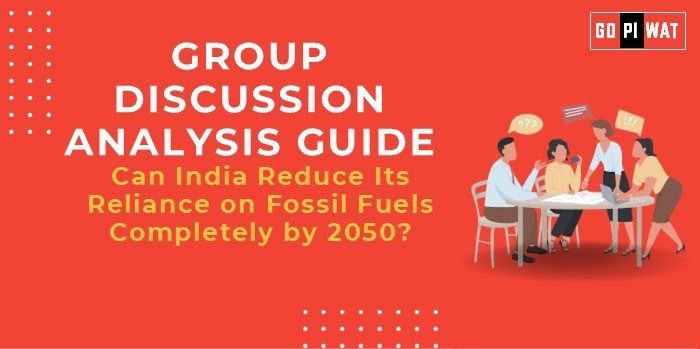📋 Group Discussion (GD) Analysis Guide: Can India Reduce Its Reliance on Fossil Fuels Completely by 2050?
🌍 Introduction to the Topic
Opening Context: “India, as one of the world’s largest energy consumers, faces the dual challenge of addressing climate change and ensuring energy security. Transitioning away from fossil fuels by 2050 could redefine its economic and environmental trajectory.”
Topic Background: Reliance on fossil fuels has underpinned global energy systems, but their environmental costs—rising greenhouse gas emissions and global warming—have sparked debates worldwide. India’s commitment to renewable energy under the Paris Agreement, aiming for net-zero emissions by 2070, raises the question: Can it achieve this transition sooner?
📊 Quick Facts and Key Statistics
- 💡 Energy Dependency: Fossil fuels account for ~59% of India’s electricity generation (2023).
- 🌞 Renewable Targets: 500 GW non-fossil capacity planned by 2030.
- 🌍 Carbon Emissions: India is the world’s third-largest emitter of CO₂.
- 💰 Economic Cost: Import of fossil fuels exceeds $150 billion annually.
- 📈 Green Energy Growth: Solar power capacity increased from 2.6 GW (2014) to 71.3 GW (2023).
🤝 Stakeholders and Their Roles
- 🏛️ Government: Setting policy frameworks, subsidies for renewables, and executing missions like the National Solar Mission.
- 🏢 Private Sector: Investments in clean energy projects and innovation in energy-efficient technologies.
- 🌐 International Organizations: Climate funding and technology transfer under UN agreements.
- 👥 Citizens: Adoption of clean technologies such as electric vehicles and rooftop solar panels.
🏆 Achievements and Challenges
✨ Achievements
- 🌱 Renewable Expansion: Installed renewable capacity of 125 GW as of 2023.
- 🚗 Electric Mobility: EV sales rose 210% between 2020 and 2023.
- 💡 Innovative Policies: Introduction of green bonds and policy support for hydrogen energy.
⚠️ Challenges
- 💰 High Cost: Renewable technology and storage infrastructure remain expensive.
- 🪵 Coal Dependency: Coal contributes to 70% of electricity production.
- 🏞️ Rural Transitions: Slow progress in rural energy transitions.
🌍 Global Comparisons
- 🇩🇰 Success Stories: Denmark aims to phase out fossil fuels by 2050, primarily via wind energy.
- 🇺🇸 Challenges Elsewhere: The US faces similar storage challenges with renewables.
📚 Case Study
Gujarat’s Solar Park: Asia’s largest solar park significantly contributes to India’s renewable energy mix but highlights land-use conflicts.
🗣️ Structured Arguments for Discussion
- ✅ Supporting Stance: “India’s rapid progress in renewables, such as achieving 71.3 GW solar capacity, indicates the feasibility of replacing fossil fuels entirely by 2050.”
- ❌ Opposing Stance: “Given India’s dependence on coal and the high costs of renewables, achieving complete reliance on green energy by 2050 seems overly ambitious.”
- ⚖️ Balanced Perspective: “While India’s renewable growth is promising, achieving fossil-free energy by 2050 will require overcoming significant technological and economic barriers.”
🎯 Effective Discussion Approaches
- 📊 Opening Approaches:
- 🔢 Use impactful statistics: “India imports $150 billion of fossil fuels annually, straining its economy and sustainability goals.”
- 📖 Highlight a case study: “Gujarat’s solar park reflects the potential but also the complexities of renewable transitions.”
- 🔄 Counter-Argument Handling: Example: “Transitioning entirely by 2050 may be difficult, but targeted policies like subsidy reallocation can accelerate adoption.”
🔍 Strategic Analysis of Strengths and Weaknesses
- 💪 Strengths: Largest renewable energy market growth, strong policy framework.
- 🤔 Weaknesses: Dependence on fossil fuels, lack of energy storage solutions.
- 🚀 Opportunities: Global leadership in renewable technology, export potential.
- ⚠️ Threats: Technology dependence, geopolitical issues in renewable supply chains.
🎓 Connecting with B-School Applications
- 🌱 Real-World Applications: Renewable energy supply chains and green finance models.
- 📝 Sample Interview Questions:
- 💬 “How can India attract more investment in renewables?”
- 💬 “Evaluate the economic implications of reducing fossil fuel reliance.”
- 💡 Insights for B-School Students: Opportunities in green startups and ESG investments.


